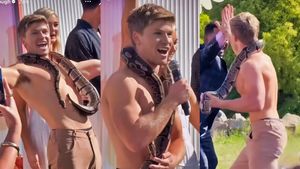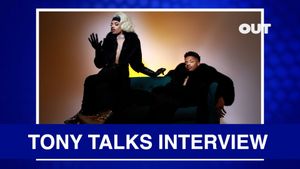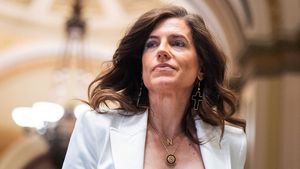Matt Lew (pictured) Painter and
photographer Chicago
Matt Lew's
Chicago studio contains a collection of water-filled plastic
bottles and glass jars labeled with distant locales like
"Turkey," "Kauai,"
"Lourdes, France," and "The
Mediterranean."
"I love
water," says Lew, 27, who grew up near Lake Tahoe and
whose Lake Shore Drive studio overlooks Lake Michigan.
Lew has built a reputation and a following with
abstract landscapes that mix seawater with paint. "I
really felt that if I took water from all different parts of
the world and infused it into my paintings, it would
bring that resonance of nature into art and into your
home," he says.
Lew collects
water on his trips, and friends return from their vacations
in places like the Brazilian rain forest with gifts of
water. Sometimes clients even commission a painting
using water from a place special to them. A couple
recently bought a
piece for their anniversary made with water from Aruba,
where they'd spent their honeymoon.
Lew's
artwork also includes other organic materials, from sand to
leaves. "A lot of times it's hidden so
you don't even know it's there," he
says. "Other times it's very
visible."
Studying for
21/2 years at the University of the Basque Country in
San Sebastian, Spain, fueled Lew's passion for
art. "We'd study Michelangelo in my
class, and then I'd travel to Florence and see the
actual painting," he recalls. "It was so
cool and so inspiring for me."
Single and
"enjoying being single," Lew uses his success
to help nonprofit groups, such as the Human Rights
Campaign and the Gay and Lesbian Alliance Against
Defamation. He has painted pieces at HRC galas that
were auctioned while he worked on them. "Anything
that I can give back is huge to me," he says.
"I get to wake up every morning, paint, and
bring beauty into the world. It's so fulfilling.
It's the coolest thing ever."
Gretchen Legler
Adventurer and writer Jay, Maine
The icy continent
of Antarctica has no native people, but it does have a
thriving lesbian population. That's just one lesson
Gretchen Legler, a professor of creative writing at
the University of Maine at Farmington, learned during
a six-month adventure in 1997 to gather material for her
book On the Ice, about the people, history, and
landscape around McMurdo Station, the largest
scientific base on the continent. "I talked to
people about why they wanted to be in such a cold, desolate,
faraway place," says Legler, 46. "And
they wouldn't have an explanation."
She also learned
how to set up a tent in a windstorm--when gusts reach
up to 70 miles per hour--and plenty about how to
keep warm. Antarctica holds the world record low
temperature: minus 128.6 degrees Fahrenheit. "I know
how to survive really, really, really cold weather,"
she says. "That gives me a big sense of
self-confidence."
As for the
lesbian population? "There was a joke going around
[the base]," says Legler. "How do you
get a date with a woman at McMurdo? Be one."
Legler did just
that. She met her partner, Ruth, now a river geologist,
while at McMurdo. The two courted Antarctica-style: walking
in the snow and cuddling by the observation tube, a
metal pipe that runs under the ice and allows
scientists to watch what's happening in the frigid
ocean. "Everyone was skeptical whether our
relationship would last once we 'got off the
ice,' " she says. "But it did."
They celebrate their 10th anniversary this year.
Legler's
next book will be based on trips to Belize and Panama.
"I get to do all of these amazing
things," she says. "I get to live this life
that's very purposeful, because I'm creating
stories out of it all of the time."
Salvo Tavella
Literature translator Buenos Aires and Rome
O.H. Villordo is
one of the most important South American gay writers of
the 1970s. And readers a world away have Salvo Tavella to
thank for reviving him. Tavella has translated two of
the Argentinean author's novels into Italian,
transporting them to another continent and a younger
generation. "If someone wants to know how gay life
was before gay pride, Gay.com, discos, and
saunas," says Tavella, "he'll find the
answer in Villordo's novels."
Italy has a
strong market for gay books, but not every novel is right
for the Italians. Currently he's translating
prize-winning author Guillermo Saccomanno's
El Pibe (The Kid), about a boy living in Buenos
Aires during the 1950s, into his native tongue.
Fluent in Italian
and Spanish, the 37-year-old Tavella also speaks
English, Japanese, and French. He playfully calls himself
the "globe-trotter writer and
translator," dividing his time between Rome,
Buenos Aires, and Patagonia, a region of mountains and
glaciers straddling Chile and Argentina. "You
have to see it to understand," says
Sicilian-born Tavella about what drew him and his partner of
five years, Gustavo, to Patagonia.
Tavella is also a
writer. His most recent short story,
"Un'estate al Supermercato"
("Summer at the Supermarket"), is about two
men who meet at the grocery. Once upon a time Tavella
was a publicist for Italian television. But six hours
a day (yes, six) in an office was too much, so he quit
to become a traveling writer. "I can bring my job
anywhere from Rome to Patagonia," he says.
"I need only a book, a pen, and some paper."
Joanne Sanders
Episcopalian priest Menlo Park, Calif.
As associate dean
for religious life at Stanford University, out lesbian
Joanne Sanders helps shape young minds. She notably wields
her influence by preaching at Stanford's
Memorial Church, teaching a class on nonviolent social
change, and forging a community among the 36 religious
groups on campus.
And she's
proof that a person doesn't have to lose her religion
because she's gay. "I spend a lot of
time with students who have come to terms with their
sexual identity, but they're wrestling with what to
do with their religious beliefs and
spirituality," says Sanders, 47.
Sanders
wasn't always a woman of the cloth. In fact, she was
a collegiate tennis coach at Grand Canyon University
and Seattle Pacific University for almost 10 years
before taking a religious path. "I always have been a
religiously devoted person within Christianity," says
Sanders, who was raised Catholic. "But I needed
to find a place where I could live out fully who I am
as a religious person and as an openly gay woman."
She found an Episcopal church with her partner, Kathy,
and within five years began studying at the Church
Divinity School of the Pacific at the Graduate
Theological Union in Berkeley, Calif.
In many
denominations it's still tough to be gay in the
clergy. Vatican-appointed investigators root out gay
students from U.S. Catholic seminaries. The
Presbyterian Church recently extended its ban on
noncelibate gay and lesbian ministers. And knowing this
makes Sanders feel even luckier. She says, "The
fact that I, as an openly gay priest, have been so
welcomed and embraced by Stanford has been huge."
Richard Koob
Hawaiian retreat guru Kalapana, Hawaii
Imagine if your
typical workday looked like this: Practice Kundalini yoga
at sunrise on the Hawaiian coast, socialize with travelers
from around the globe, trek to the beach, sit in on a
few staff meetings, play volleyball, and recover in
the hot tub. And if it's Tuesday, teach hula.
That's the
life of Richard Koob, 60, the director of Kalani Oceanside
Retreat, a 120-acre getaway along one of the most unspoiled
coastlines on the Big Island. Koob opened his
nonprofit retreat in 1982 with his partner (Earnest
Morgan, who died in 1985 of AIDS complications) as a
place dedicated to nature, culture, and well-being.
"It's important to enjoy life and focus
on doing what we really love," says Koob.
Many of
Kalani's activities, including dance and workshops
such as a yoga retreat for gay men, reflect
Koob's personal passions. "We've been
on the vanguard of helping gay men realize how
important it is to develop one's soulful and
sensual side," he says.
An eclectic
clientele is drawn to its rejuvenating massages, hula
classes, historical sites, and breathtaking lava-walled
cliffs. Accommodations range from $30 campsites to
$260-a-night tree houses. Koob and Morgan always
intended Kalani to attract people from a variety of
backgrounds--both financial and cultural. Says Koob:
"I think that appreciation of diversity comes
from the gay experience."
Evan Darling
Race car driver Fort Lauderdale, Fla.
Growing up in
Andover, Mass., Evan Darling used to challenge neighborhood
kids to race him and his Big Wheel. He quickly graduated to
gas-powered go-karts, BMX bikes, and by his 16th
birthday, his first motocross motorcycle. "I
was the little racer in the neighborhood," says
Darling. Now 39, he's racing cars
professionally with hopes of eventually graduating to
NASCAR.
Darling is
perhaps the only out gay U.S. driver in the macho world of
professional racing. (Canadian stock car racer Billy Innes
is gay; American ex-NASCAR driver James Terrell Hayes
became Terri O'Connell, the first transgender
driver, after sex-reassignment surgery in the mid
'90s.)
"Surprisingly, everyone so far has been very
supportive and very understanding," says
Darling. "The fans I have seem to be very
intelligent and very accepting."
Off the racing
circuit Darling has traveled a bumpy road since coming at
age 18. How rough? His parents sent him to a psychologist,
and his brother, Brian, returned from college with a
pile of straight is great T-shirts. Today, his brother
serves as director of Senate relations for the antigay
Heritage Foundation. But Darling's relationship with
his parents has improved. "It's taken a
lot of work," he says. "I've had to
ignore a lot of things and just accept them as my
family."
Funding his
career has been tough too. Professional race cars cost more
than $100,000. So when he goes to events like this
month's Grand Prix in Watkins Glen, N.Y., on
the IndyCar circuit, he rents a car
for $7,000 to
$10,000 per weekend. And soliciting sponsors to put their
logos on his car isn't easy. "I'm
finding it's difficult to get big companies to
sponsor a gay person in a straight marketplace," says
Darling.
But he remains
determined: "The coolest part of my job is when I get
into a race car, shut the rest of the world out, and
enjoy the feeling of doing well. Being gay
doesn't define what you can and can't do in
life."
Dustin Portillo
Circus clown Independence, Mo.
Many kids dream
of running away with the circus, but Dustin Portillo did
it. "No firefighter. No paramedic," he says.
"I wanted to be a clown." Now 20,
Portillo lives the dream by touring with Ringling Brothers
and Barnum & Bailey.
As it turns out,
being a clown isn't child's play. Portillo
studied for two years at Mooseburger Camp in Buffalo,
Minn., which is run by a former Ringling Brothers
clown. "They teach you everything," says
Portillo. "How to fall, how to throw pies, how
to water-spit, how to put on makeup, how to juggle,
how to plate-spin."
He's on a
two-year tour of "Bellobration," the 137th
edition of the Greatest Show on Earth, named for
strawberry-blond clown star Bello Nock. But Portillo
steals the spotlight with a visual gag in which he tries to
take a bite out of a Macintosh computer and again when he
and the other clowns parody Dancing With the
Stars. One of those other clowns is
Portillo's boyfriend. "I guess you'd
have to say it was fate," Portillo says of
their meeting a year ago. "We both like clowning, we
both like the circus, and we're both
gay." The two travel town to town in separate
but neighboring rooms on the Ringling Brothers train.
"If I want to see him, I go 10 feet,"
Portillo says. "Knock, knock."
When
they're not wearing oversize shoes, the couple play
tourist. Between recent performances at Madison Square
Garden, they saw six Broadway shows. But nothing can
keep them from the big top. "I love to make people
laugh," says Portillo. "Every single day I
come to work I get to perform in front of an audience
of 10,000 people, and every single one is going to
leave with a lighter heart."
Christopher Webb
Color and trend designer/general motors
Warren, Mich.
Whether
it's the "victory red" of the Chevrolet
Corvette or "pewter metallic" of the
Hummer H2, every color offered by General Motors in
North America starts with Christopher Webb. The 31-year-old
not only picks the colors but develops them
(22 new ones each
year) and names them: "blue chip" for
Cadillac, "rally yellow" for the Chevy
Cobalt, "grenade green" for the Hummer H3.
He's also created custom colors for cars in
movies such as The Matrix and TV shows such as
The Sopranos.
A native of the
United Kingdom, Webb was studying fashion design at the
University of Brighton when GM came knocking seven years
ago. And while friends worried that Detroit would be
too straight, white, and middle-aged, the single Webb
says, "To be honest, I've come into the most
accepting, wonderful environment."
One of the
biggest differences Webb has found between the runway and
the roadway is timing. Fashion designers are now
working on their 2009 lines, but GM is now planning
models as far in the future as 2015. Still, "when
you're developing color, whether you're
wrapping color and material around a human form or
around a car interior, it's very similar,"
says Webb. "I'm working on
trends." So what's on the horizon? The
ascension of orange, blue, and purple.
Randy Neece & Joe Timko
Dog trainers Topanga, Calif.
Joe Timko was
waiting as a black Cadillac Escalade pulled up outside
Canyon View Dog Ranch, carrying Jennifer Lopez, Marc
Anthony, and their mastiff.
Timko, 50,
didn't flinch. Canyon View is a cage-free-range
boarding estate a quarter mile from Malibu, Calif.,
that sports a bone-shaped doggy pool and a running
list of celebrity clients, including Christina
Aguilera, Vin Diesel, and anyone else willing to pay $50 a
day for boarding and $1,975 for four weeks of
obedience training.
While Timko and
his life partner, Randy Neece, aren't starstruck,
they certainly know how lucky they are. In 1996, Neece
was near death from AIDS complications when the
antiretroviral cocktail finally became available.
"You don't get much further than I was and
still come back," says Neece, 54, author of the
new memoir Gone Today, Here Tomorrow. As
Neece's health improved, the couple began creating
what Neece pictured as "a Disneyland for
dogs." They replaced the scrub-covered land with
trees, well-manicured lawns, and flowers. The business
took off; they terraced the play areas and added
tunnels so dogs could run under as well as over the
lawn. They planted a bamboo garden, built a koi pond, and
landscaped the land in ways that would make Walt
Disney envious.
"Our
philosophy was simple: We wanted a place where we feel
comfortable putting our own dogs," says Neece.
"And our own dogs are like our
children."
Violet Palmer
NBA referee Los Angeles
When a National
Basketball Association scout telephoned to ask Violet
Palmer if she wanted to join the association's
referee training program, she thought it was a prank
call. Palmer was then a NCAA Women's Division I
basketball referee; she had never considered NBA refereeing
a possibility.
Two years later
it was a reality. In 1997, Palmer was the first woman to
officiate a regular-season NBA game, between the Dallas
Mavericks and Vancouver Grizzlies.
Naturally, she
became the target of curiosity and derision. Before
she'd even stepped on the court, NBA all-star
Charles Barkley told reporters, "I don't
think women should be in the army, and I don't think
they should be NBA refs."
But in a job
where fans heckle and coaches scream, turning a deaf ear
becomes second nature. "I knew if I had an
opportunity to prove myself," she says,
"there would be no question that I could do the
job." And she was right. In the
2006-2007 season she officiated 72 out of 82 games.
Palmer, now 42,
was initially cautious about disclosing her sexual
orientation. "I wanted my merit and my work to be the
focal point," she says. "Now, 10 years
in, saying I'm a lesbian doesn't
matter." And now her partner of 12 years, Tanya
Stine, gets to join her at games.













































































